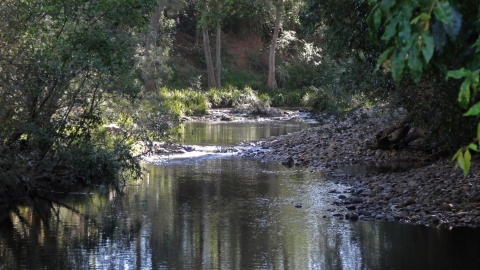3.1 A fit-for-purpose model
Many regions have existing groundwater models but that does not necessarily mean that they are suitable for use in BA. Any existing models need to be evaluated to ensure that they are fit for purpose for use in BA. Table 3 lists the criteria a groundwater model in BA needs to satisfy to be considered fit for purpose for BA. If an existing model cannot be used in BA then a new model would need to be developed that does comply with the criteria in Table 3.
Table 3 Assessment of groundwater numerical modelling approach in bioregional assessments
Each of the criteria in Table 3 should be discussed in product 2.6.2 (groundwater numerical modelling) and the assumptions inherent in them. A discussion of these criteria forms part of the qualitative uncertainty analysis that is further described in the companion submethodology M09 (as listed in Table 1) for propagating uncertainty through models (Peeters et al., 2016).
3.2 Model code
The transparency requirements of the Bioregional Assessment Programme mean that the models used need to be made publicly available. This will ensure that the experts outside of the Assessment team can run the models and obtain the same results. This requires that the models are developed using public domain software and are independent of proprietary graphical user interfaces.
There are many different model types available that have been used for modelling the groundwater impacts of coal seam gas (CSG) and/or coal mining development; these include analytical, axisymmetric and numerical models. A useful summary of these is provided in Coffey Geotechnics (2014). Different model types and model codes have been chosen to be used in different subregions or bioregions due to the differing requirements in each subregion or bioregion. These include considerations such as data availability, intensity of development and the scheduling of extraction of coal resources. Model codes chosen for each subregion or bioregion to date include:
- hybrid analytical element-numerical model using TTim (Bakker, 2013) and MODFLOW (Harbaugh and McDonald, 1996) (Gloucester subregion)
- analytical element model using TTim (Bakker, 2013) (Galilee subregion)
- numerical model developed in MODFLOW (Harbaugh and McDonald, 1996) (Clarence-Moreton bioregion and Namoi subregion)
- numerical model developed in MOOSE (Wilkins, 2015) (Hunter subregion)
- existing jurisdictional MODFLOW (Harbaugh and McDonald, 1996) model (Maranoa-Balonne-Condamine subregion).
A deterministic MODFLOW groundwater model was also developed as a related product for Galilee subregion.
In the Bioregional Assessment Technical Programme, no groundwater modelling was undertaken for Gwydir, Central West, Arckaringa, Pedirka and Cooper subregions. State jurisdiction models exist for Arckaringa, Pedirka and Cooper subregions and the Gippsland Basin bioregion.
This submethodology has been written to be independent of any specific model code to remain generally applicable to all subregions or bioregions. This means that it is pitched at a conceptual level; specific details will be written in product 2.6.2 (groundwater numerical modelling) for each Assessment.
The Methodology for bioregional assessments of the impacts of coal seam gas and coal mining development on water resources (Barrett et al., 2013) discusses the requirements for dual-phase flow, geomechanical deformation and solute transport modelling in a BA. This modelling will not be performed in the current round of BAs due to operational constraints. The implication of only using single-phase flow modelling is that impacts due to CSG developments could be overestimated (Herckenrath et al., 2015). Geomechanical deformation modelling will not be conducted in this round of BAs but the impact of subsidence on the hydraulic properties of the aquifers and aquitards will be incorporated in the modelling (where possible) through an increase in hydraulic conductivity above and below longwall mining areas. It is not possible to vary hydraulic properties for the analytical element models, thus this is only done where the Programme has developed numerical groundwater models.

METHODOLOGY FINALISATION DATE
- 1 Background and context
- 2 Modelling philosophy
- 3 Choice of model
- 4 Boundary conditions
- 5 Model time steps and predictive time frame
- 6 Integration with surface water modelling
- 7 Parameterisation
- 8 Calibration, sensitivity analysis and uncertainty analysis
- 9 Meeting the requirement for transparency
- 10 Outputs from groundwater modelling
- References
- Glossary
- Citation
- Acknowledgements
- Contributors to the Technical Programme
- About this submethodology
